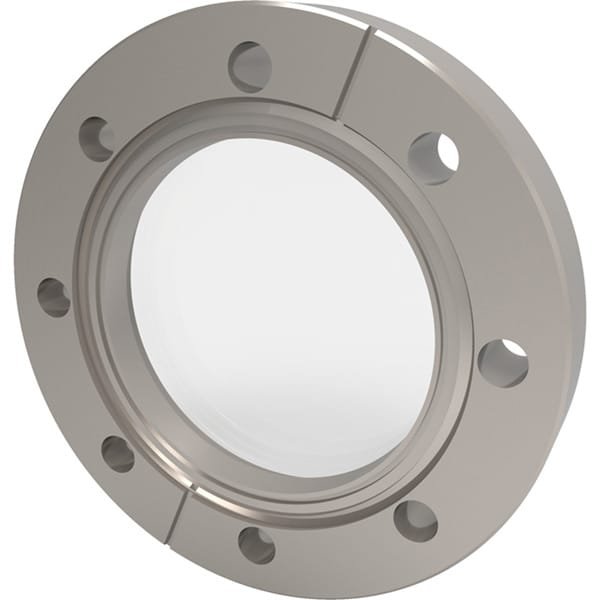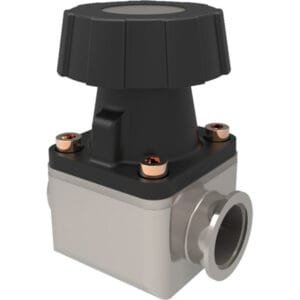CF Flanged Quartz (Fused Silica) Viewports for UHV Optical Applications
CF Flanged Quartz (Fused Silica) Viewports by TFM are engineered for ultra-high vacuum (UHV) systems that demand high-transmission optical access while maintaining exceptional vacuum integrity. These viewports are built with fused silica (quartz) lenses mounted inside CF (ConFlat®) flanges, ensuring superior performance across a wide range of optical and environmental conditions.
The quartz lens provides broad spectral transmission, typically ranging from 200 nm (deep UV) to over 2.5 µm (near-IR), making these viewports ideal for use in laser systems, spectroscopy, visual inspection, and plasma diagnostics. Fused silica also offers low thermal expansion and chemical resistance, ensuring long-term durability in aggressive environments.
Each CF Flanged Quartz (Fused Silica) Viewport is sealed using fully annealed copper gaskets, allowing knife-edge flanges to form leak-tight, metal-to-metal UHV seals. This sealing method supports vacuum pressures as low as 10⁻¹⁰ Torr, and the entire assembly is bakeable to 250°C, enabling thorough outgassing and cleaning.
When installed in deposition systems (e.g., PVD, CVD, sputtering), it’s highly recommended to use a viewport shutter to prevent optical degradation from coating buildup on the quartz surface.
Key Features of CF Flanged Quartz (Fused Silica) Viewports:
UHV Compatibility: Suitable for ultra-high vacuum systems down to 10⁻¹⁰ Torr.
Broad Wavelength Range: Excellent transmission from 200 nm to 2500 nm, ideal for UV, visible, and IR applications.
Durable Construction: Quartz lens paired with 304L stainless steel CF flanges for corrosion and thermal resistance.
Metal Seal Reliability: Uses annealed copper gaskets for robust, vacuum-tight metal sealing.
High-Temperature Bakeability: Viewports are stable for bakeout procedures up to 250°C.
Recommended Applications:
Laser optics ports in vacuum chambers
UHV inspection and optical diagnostic access
Photonic research setups requiring quartz windows
Deposition systems with in-situ optical monitoring
TFM’s CF Flanged Quartz (Fused Silica) Viewports are trusted in industries ranging from semiconductor fabrication to materials science research. They provide the ideal balance between optical precision, thermal resilience, and UHV sealing, ensuring long-lasting performance in the most demanding vacuum environments.
Charts
|
Drawing |
Flange / Mounting |
Window Material |
Wavelength Optimization |
Reflection (avg) |
View Area |
Window Thickness |
Flange Material |
Sleeve Material |
PartNumber |
 
|
DN16CF (1.33" OD) |
Corning HPFS 7980 Fused Silica |
— |
— |
0.63 |
0.085 |
304L SS |
304L SS |
VPZL-133DU |
 
|
DN35CF-DN40CF (2.75" OD) |
Corning HPFS 7980 Fused Silica |
— |
— |
1.40 |
0.125 |
304L SS |
304L SS |
VPZL-275DU |
 
|
DN50CF (3.38" OD) |
Corning HPFS 7980 Fused Silica |
— |
— |
1.40 |
0.125 |
304L SS |
304L SS |
VPZL-337DU |
 
|
DN63CF (4.50" OD) |
Corning HPFS 7980 Fused Silica |
— |
— |
2.69 |
0.250 |
304L SS |
304L SS |
VPZL-450DU |
 
|
DN75CF (4.63" OD) |
Corning HPFS 7980 Fused Silica |
— |
— |
2.69 |
0.250 |
304L SS |
304L SS |
VPZL-463DU |
 
|
DN100CF (6.00" OD) |
Corning HPFS 7980 Fused Silica |
— |
— |
3.88 |
0.250 |
304L SS |
304L SS |
VPZL-600DU |
 
|
DN35CF-DN40CF (2.75" OD) |
Corning HPFS 7980 Fused Silica Excimer Grade 193 |
— |
— |
1.40 |
0.125 |
304L SS |
304L SS |
VPZL-275EU |
 
|
DN63CF (4.50" OD) |
Corning HPFS 7980 Fused Silica Excimer Grade 193 |
— |
— |
2.69 |
0.250 |
304L SS |
304L SS |
VPZL-450EU |
 
|
DN16CF (1.33" OD) |
Corning HPFS 7980 Fused Silica |
— |
— |
0.63 |
0.085 |
304L SS |
304L SS |
VPZL-133Q |
 
|
DN35CF-DN40CF (2.75" OD) |
Corning HPFS 7980 Fused Silica |
— |
— |
1.40 |
0.125 |
304L SS |
304L SS |
VPZL-275Q |
 
|
DN50CF (3.38" OD) |
Corning HPFS 7980 Fused Silica |
— |
— |
1.40 |
0.125 |
304L SS |
304L SS |
VPZL-337Q |
 
|
DN63CF (4.50" OD) |
Corning HPFS 7980 Fused Silica |
— |
— |
2.69 |
0.250 |
304L SS |
304L SS |
VPZL-450Q |
 
|
DN75CF (4.63" OD) |
Corning HPFS 7980 Fused Silica |
— |
— |
2.69 |
0.250 |
304L SS |
304L SS |
VPZL-463Q |
 
|
DN100CF (6.00" OD) |
Corning HPFS 7980 Fused Silica |
— |
— |
3.88 |
0.250 |
304L SS |
304L SS |
VPZL-600Q |
 
|
DN125CF (6.75" OD) |
Corning HPFS 7980 Fused Silica |
— |
— |
3.88 |
0.250 |
304L SS |
304L SS |
VPZL-675Q |
 
|
DN160CF (8.00" OD) |
Corning HPFS 7980 Fused Silica |
— |
— |
5.38 |
0.375 |
304L SS |
304L SS |
VPZL-800Q |
 
|
DN200CF (10.00" OD) |
Corning HPFS 7980 Fused Silica |
— |
— |
7.78 |
0.375 |
304L SS |
304L SS |
VPZL-1000Q |
 
|
DN16CF (1.33" OD) |
Corning HPFS 7980 Fused Silica |
550-1100nm |
<0.75% Per Surface |
0.63 |
0.085 |
304L SS |
304L SS |
VPZL-133DUC3 |
 
|
DN16CF (1.33" OD) |
Corning HPFS 7980 Fused Silica Excimer Grade 248 |
225-450nm |
<1.5% Per Surface |
0.63 |
0.085 |
304L SS |
304L SS |
VPZL-133EUC1 |
 
|
DN35CF-DN40CF (2.75" OD) |
Corning HPFS 7980 Fused Silica Excimer Grade 248 |
225-450nm |
<1.5% Per Surface |
1.40 |
0.125 |
304L SS |
304L SS |
VPZL-275EUC1 |
 
|
DN35CF-DN40CF (2.75" OD) |
Corning HPFS 7980 Fused Silica |
425-760nm |
<0.5% Per Surface |
1.40 |
0.125 |
304L SS |
304L SS |
VPZL-275DUC2 |
 
|
DN35CF-DN40CF (2.75" OD) |
Corning HPFS 7980 Fused Silica |
550-1100nm |
<0.75% Per Surface |
1.40 |
0.125 |
304L SS |
304L SS |
VPZL-275DUC3 |
 
|
DN63CF (4.50" OD) |
Corning HPFS 7980 Fused Silica Excimer Grade 248 |
225-450nm |
<1.5% Per Surface |
2.69 |
0.250 |
304L SS |
304L SS |
VPZL-450EUC1 |
 
|
DN63CF (4.50" OD) |
Corning HPFS 7980 Fused Silica |
425-760nm |
<0.5% Per Surface |
2.69 |
0.250 |
304L SS |
304L SS |
VPZL-450DUC2 |
 
|
DN63CF (4.50" OD) |
Corning HPFS 7980 Fused Silica |
550-1100nm |
<0.75% Per Surface |
2.69 |
0.250 |
304L SS |
304L SS |
VPZL-450DUC3 |
 
|
DN100CF (6.00" OD) |
Corning HPFS 7980 Fused Silica |
425-760nm |
<0.5% Per Surface |
3.88 |
0.250 |
304L SS |
304L SS |
VPZL-600DUC2 |
 
|
DN100CF (6.00" OD) |
Corning HPFS 7980 Fused Silica |
550-1100nm |
<0.75% Per Surface |
3.88 |
0.250 |
304L SS |
304L SS |
VPZL-600DUC3 |





Reviews
There are no reviews yet.